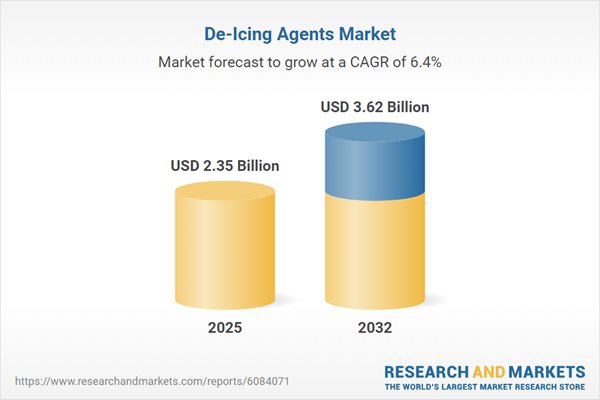Speak directly to the analyst to clarify any post sales queries you may have.
Effective winter maintenance is essential to ensure continuity and safety for transportation networks and public infrastructure. The de-icing agents market plays a pivotal role in supporting reliable operations during severe weather, with procurement and senior leaders facing evolving requirements, advanced technologies, and dynamic supply chain conditions.
Market Snapshot: De-Icing Agents Market Growth Outlook
The de-icing agents market demonstrated robust performance, expanding from USD 2.21 billion in 2024 to USD 2.35 billion in 2025. Current projections indicate a continuing compound annual growth rate (CAGR) of 6.36%, leading to an anticipated market value of USD 3.62 billion by 2032. Growth is driven by sustained needs for winter maintenance across critical areas including airports, highways, and urban infrastructure. The market shows accelerated adoption of environmentally conscious and advanced formulations, as stakeholders respond to intensifying environmental regulations and unpredictable weather patterns. Product differentiation increasingly hinges on innovative deployment methods and enhanced environmental profiles.
Scope & Market Segmentation
This report dissects the de-icing agents market through detailed segmentation, empowering leaders to align procurement and operational strategies with the sector's most impactful developments.
- Product Types: Includes acetate-based solutions (such as calcium magnesium acetate and potassium acetate), chloride-based compounds (calcium chloride, magnesium chloride, sodium chloride), organic-based alternatives including biotechnological and glycol-based agents, and urea-based solutions. Each product type is evaluated for effectiveness, environmental safety, and suitability across multiple climates and uses.
- Applications: Covers diverse contexts from airport runways and public highways to sidewalks and bike paths, reflecting varied operational and safety challenges across these infrastructure types.
- Form Factors: Encompasses both liquid solutions (including brine and glycol) and solid preparations, recognizing the influence of form on application efficiency and logistics.
- End Users: Profiles commercial airports and airlines, municipal authorities, and residential property managers, each category with unique performance and compliance requirements shaping product selection.
- Distribution Channels: Involves dealers and distributors on both local and national scales, direct sales models, as well as expanding e-commerce approaches such as company-owned platforms and broader marketplaces.
- Regional Coverage: Spans key geographies: North America and Latin America, a broad swath of Europe, Middle East and Africa, plus major Asia-Pacific economies, highlighting market drivers and operational variations regionally.
- Leading Companies Profiled: Key industry players analyzed include Compass Minerals International, Inc., Cargill, Incorporated, K+S Aktiengesellschaft, BASF SE, Dow Inc., Ecolab Inc., Eastman Chemical Company, Solvay SA, LANXESS AG, and Clariant AG. Their roles and innovations are assessed relative to sector trends and procurement priorities.
Key Takeaways: Strategic Insights for Decision-Makers
- Market-wide sustainability concerns are accelerating the transition toward biodegradable and organic de-icing agents, with regulatory frameworks shaping adoption strategies.
- Technology integration, notably in weather analytics and precise application methods, empowers operators to optimize de-icing efforts while reducing chemical consumption.
- Supply chain adjustments are being prioritized, as increased trade policy intricacies prompt companies to explore regional partners and nearshoring strategies for risk mitigation.
- Product innovation is increasingly influenced by end-user sectors, as commercial, municipal, and residential buyers set diverse performance and safety demands, guiding R&D investments.
- Varied distribution models, including growth in e-commerce and direct sales, broaden access while adding flexibility for purchasing organizations in different geographies and sectors.
- Competitive positioning is adapting via mergers, acquisitions, and strategic alliances, underscoring the importance of agile market strategies in response to evolving industry structures.
Tariff Impact: Navigating Policy Shifts
Recent updates to tariff policies in the United States have introduced new complexities for organizations sourcing de-icing agent inputs. Higher costs for precursor chemicals are influencing procurement planning and contracting. In response, many firms are scaling investment in domestic manufacturing and diversifying their suppliers, enhancing resilience and reducing overreliance on international trade channels.
Methodology & Data Sources
This analysis is grounded in a dual approach, combining primary interviews with leaders, users, and regulators with secondary research from trade publications, proprietary databases, and official production records. Data has been validated using robust scenario modeling and geospatial mapping to ensure reliable, actionable findings.
Why This Report Matters
- Informs strategic procurement, portfolio management, and resilience planning for winter-critical infrastructure.
- Delivers insights into technological progression and sustainability adaptations, guiding operational priorities.
- Prepares executive decision-makers for shifting regulatory and supply chain environments that affect long-term competitiveness.
Conclusion
De-icing agents are evolving to meet more complex operational, technological, and compliance expectations. Senior leaders who align their strategies with sustainable innovations and resilient distribution practices will strengthen continuity and performance in winter-critical initiatives.
Table of Contents
3. Executive Summary
4. Market Overview
7. Cumulative Impact of Artificial Intelligence 2025
Companies Mentioned
The companies profiled in this De-Icing Agents market report include:- Compass Minerals International, Inc.
- Cargill, Incorporated
- K+S Aktiengesellschaft
- BASF SE
- Dow Inc.
- Ecolab Inc.
- Eastman Chemical Company
- Solvay SA
- LANXESS AG
- Clariant AG
Table Information
| Report Attribute | Details |
|---|---|
| No. of Pages | 186 |
| Published | November 2025 |
| Forecast Period | 2025 - 2032 |
| Estimated Market Value ( USD | $ 2.35 Billion |
| Forecasted Market Value ( USD | $ 3.62 Billion |
| Compound Annual Growth Rate | 6.3% |
| Regions Covered | Global |
| No. of Companies Mentioned | 11 |









